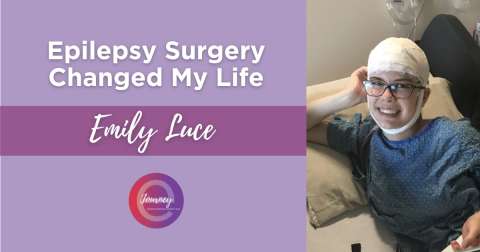Epilepsy Surgery Changed My Life

By Emily Luce , Michigan
Person with EpilepsyI was diagnosed with epilepsy when I was 8 years old. Once I was put on medication, controlling the seizures wasn't hard. For several years, epilepsy was something I lived with but didn't think about very much. Besides taking medication and annual electroencephalography (EEG), I often forgot I had it!
By the time I was 16, I did not have a seizure in two years, so my neurologist weaned me off my medication to see if I still had seizures because I might have outgrown epilepsy. Unfortunately, it became evident that I still had it, and I went back on my medication. My doctor tried a few secondary anti-seizure medicines to help control them. Still, the adverse side effects were so significant that staying on them was not ideal, plus the seizures never went away. My doctor then determined that I had drug-resistant epilepsy, which is epilepsy that cannot be controlled with medicine.
In the summer after my senior year of high school, my neurologist brought up epilepsy surgery as a possible option. At this point, I had not taken driver's training yet and was willing to try almost anything to gain seizure control to get my license. The timing was perfect since I was taking a year to work before considering college.
I began undergoing the surgery evaluation and testing to see if I was a candidate for the epilepsy resection that fall. The tests would pinpoint the area of my brain that caused seizures and determine if removing that part was safe with no loss of function. I had a single-photon emission computed tomography (SPECT) test, which is a nuclear radiology study that measures the blood flow in the brain.
I also had magnetoencephalography (MEG), which provides a noninvasive tool to study epilepsy and brain function. Finally, I had a Stereo-EEG (SEEG) where electrodes are placed deep in the brain to find the precise region where seizure activity starts. I had a medium-sized brain bleed during the one-hour removal of the electrodes. After a few months, I returned to normal after overcoming minor language difficulties.
It was a year and a half since I began the process, but after the SEEG, I was eligible for the resection. The recovery was fast, and I was in less pain than the SEEG. I had a few problems with the incision healing during the year following the surgery, but my head is now back to normal. I have not had a seizure since before the resection. Six months after the surgery, I weaned off my secondary anti-seizure medicine, and a year after the surgery, I began weaning off my primary anti-seizure medicine. I am now off both and am doing fantastic!
My journey, however, isn't over. At almost 21 years old, I still don't have my license. I struggled immensely with watching my friends gain licenses and independence that I didn't have yet, but I hope to have soon. I can start driving again in two months once I renew my permit. I cannot confidently say that I am no longer a person with epilepsy until five years have passed with no seizures. Despite this, I am overjoyed by how successful the surgery was.
My faith got me through the surgery. Anyone who knows me knows that the thought of brain surgery would have left me trembling in a corner with fear, but my faith provided a peace so incomprehensible that I was almost not scared of surgery. This journey has taught me some wonderful things, such as how to be patient and how important my faith is to me.
If you have epilepsy, you are not alone! Epilepsy is challenging physically, emotionally, mentally, and socially. While epilepsy surgery was right for me, it may not be for everyone. I encourage you to talk with your doctor about your options too.
Reviewed By: Sara Wyen
